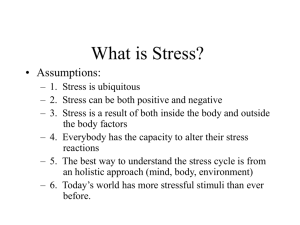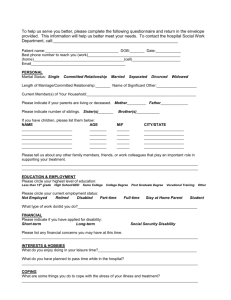PHYSIOLOGICAL PSYCHOLOGY
advertisement
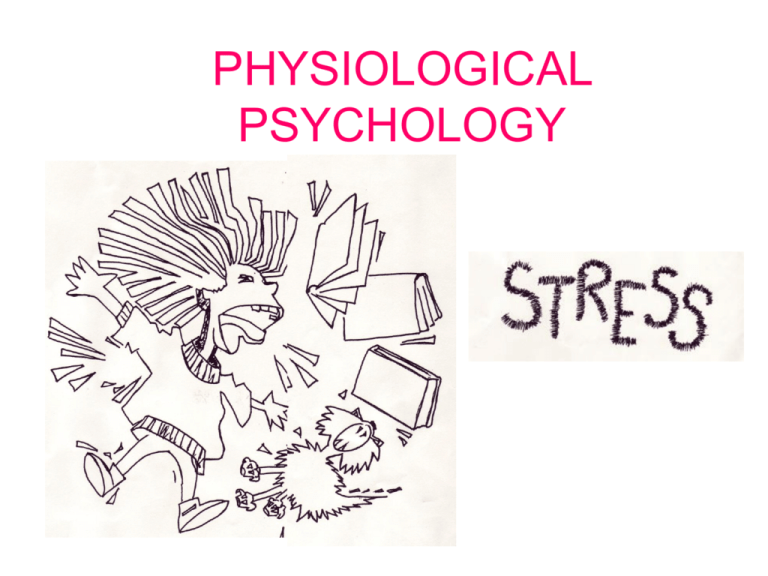
PHYSIOLOGICAL PSYCHOLOGY Explanation of behaviour that refer to the body systems – cells, muscles, blood, hormones and the nervous system. PHYSIOLOGICAL PSYCHOLOGY Miranda Psychology Physiological Psychology STRESS Section 1 Stress as a bodily response Section 3 Critical Issues: Stress management Section 2 Sources of stress What is stress? ton Pressures, demands (stressors), exert force on the body, stress is the body’s response to this. A stress response is an innate, defensive and adaptive reaction ton Stress levels also depend on whether the person feels that they can cope with demands placed on them or not ton Stress Definition Stress is a state of psychological and physical tension produced when an individual perceives that they are unable to cope with the demands imposed on them by a stressor. The consequent state of tension can be adaptive (eustress) or maladaptive (distress) Effects of stress STRESSORS Family Relations RETURN TO NORMAL Disagreements FLIGHT Money Worries Need to Succeed Exams COPING Friends Decisions RELAXATION New Situations NOT COPING POOR DIET NO EXERCISE NEGATIVE THOUGHT IRRITABILITY POSSIBLE DISEASE OR MENTAL ILLNESS EXHAUSTION The Biology Of Stress PHYSIOLOGICAL AROUSAL : Walter Cannon(1932) The response to stress Stress and the nervous system Neurons Neurotransmitters AUTONOMIC NERVOUS SYSTEM Automatically responds to stressor Sympathetic Parasympathetic ENDOCRINE SYSTEM GLANDS HORMONES Contrasting Communication Systems Nervous Endocrine Consists of nerve cells Consists of ductless glands Acts by transmitting nerve impulses Acts by releasing hormones Acts rapidly Acts slowly Direct control Indirect control Specified localised effects of neurotransmitters Hormones spread around body Short lived effects Hormones remain in blood for some time Homeostasis The process of maintaining a reasonable constant internal environment in the body. 98.6 F 37 ºC or Sympathetic Adrenal Medullary System -Hypothalamic -Pituitary -Adrenal - axis SAM HPA Work together to control stress response Effects of SAM activity • Heightened activity of SAM prepares us for Fight or Flight. Increase in energy Increased alertness Increased blood flow to the muscles Increased heart and respiration rate Reduced activity in digestive system Increased release of clotting factors in the blood Adrenaline and Noradrenaline increase the output of the heart ,which can cause increase in Blood Pressure. Effects of HPA activity + Cortisol is important for coping with long term stress,it maintains a steady supply of fuel. +Glucocorticoids conserve glucos for neural tissues, elevate or stabilise blood glucose levels,mobilise protein reserves, conserve salts and water. +Cortisol helps reverse bodies initial stress responses and helps body to revert to a stable state. Effects of HPA activity - The blood has elevated levels of glucose (for energy) and hormones (ACTH and adrenaline) so the body continues to use its resources fast. - The anti inflammatory action of glucocorticoids slows wound healing - Glucocorticoids suppress the immune system which protects the body against viruses and bacteria.(so we are more likely to pick up infection.) General Adaptation Syndrome G.A.S Hans Selye(1936) - ‘STRESS’ research PIONEER Rats showed same symptoms in response to all of Stimuli. General state of ‘stress’ STAGE 1 . ALARM: STAGE 2. RESISTANCE STAGE 3. EXHAUSTION Evaluation of GAS + Pioneering research into stress + Alerted medicine to the importance of stress in disease - Not much attention paid to SAM , the relationship between SAM and HPA not fully appreciated - Stress does not always produce the same physiological patterns. Mason (1975)different patterns of adrenaline/noradrenaline and cortisol for different stressors. - Criticised for use of non human animals - Suggestion that people respond in a passive way to stress. Mason. How does stress cause physical illness? DIRECTLY SUPPRESSING THE IMMUNE SYSTEM Leucocytes (white blood cells) INDIRECTLY Changes in health practices that will increase risk of illness Lymphocytes (B Cells or T Cells) Smoking Anti bodies Drinking Natural killer cells Drugs Endorphins Sleeplessness CARDIOVASCULAR DISORDERS Exercise less Hypertension CHD Strokes What sorts of illness does stress cause? Monkey CHD Friedman & Rosenman Air Traffic Controller Ulcers Hypertension Brady Cobb & Rose Business Man Sources of Stress Lesson objectives: Identifying sources of stress Theory-Assessing own stress levels using SRRS, a way of identifying a link with life events, sources of stress and illness. Evidence for SRRS Evaluating this approach Checking knowledge. SOURCES OF STRESS Transactional Model Cox (1978) LIFE EVENTS as stressors Social Readjustment Rating Scale Holmes and Rahe Key Study : Rahe et al stress of life events Correlation stress related illness De Longis et al DAILY HASSLES e.g. & UPLIFTS rising prices home maintenance crime physical appearance (bad hair day?) recreation weight relations with friends / family good weather job promotion Work Place Stress Pressures of work Work environment BURNOUT Key Study : Marmot et al ‘Workplace Stressors’ NOISE (Glass et al) Predictability Controllability Higher Stress? Control Lack of Control Langer and Rodin ‘Old Peoples Homes’ Individual Differences Can be innate or learned Personality – Friedman & Rosenman Gender Culture Taylor Franken Houser Hastrup et al Ogden Gyton & Hall Hardiness - Kobasa Weg Anderson Cooper et al Bailey & Dua STRESS ! Critical Issue STRESS MANAGEMENT STRESS MANAGEMENT Physiological Approaches Psychological Approaches Bio feedback Cognitive therapies .Stress inoculation training Anti Anxiety Drugs .Hardiness training Beta Blockers Benzodiazepines Social Support MULTIDIMENTIONAL COPING INVENTORY Coping strategies that different people use to handle stressful situation • Task orientated strategy • Emotional orientated strategy • Avoidance orientated strategy
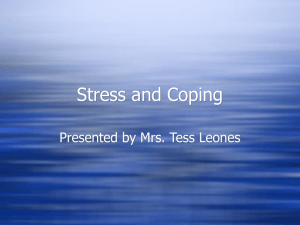
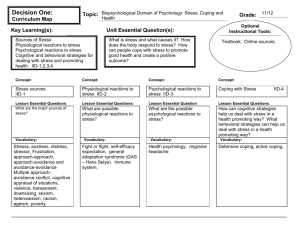

![stress response]](http://s2.studylib.net/store/data/010024037_1-8c1f8a9db34b15333b06e0b24d6f9abc-300x300.png)
